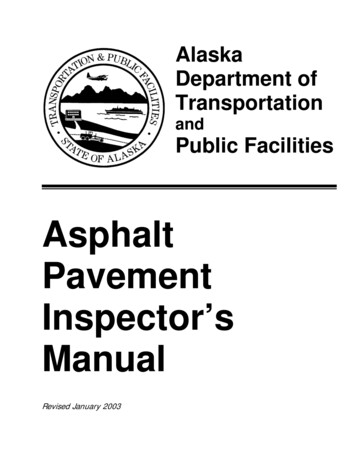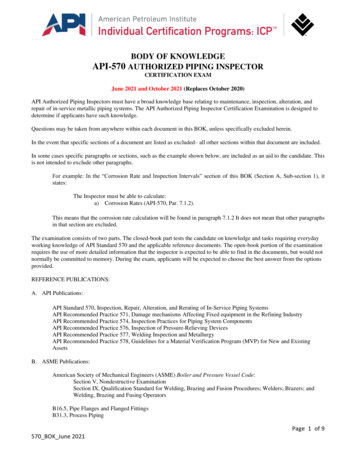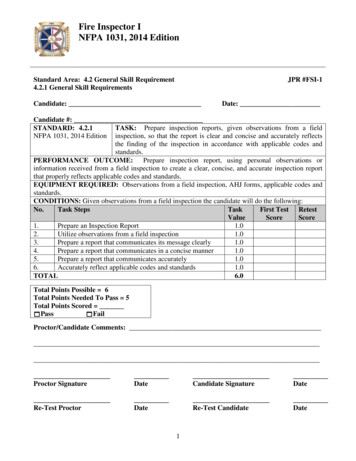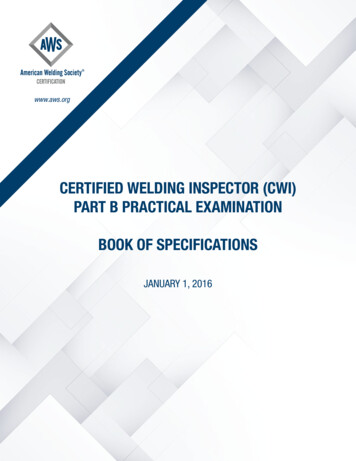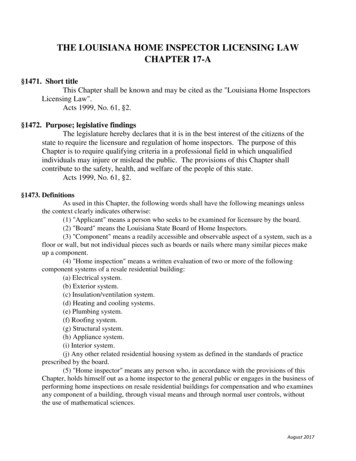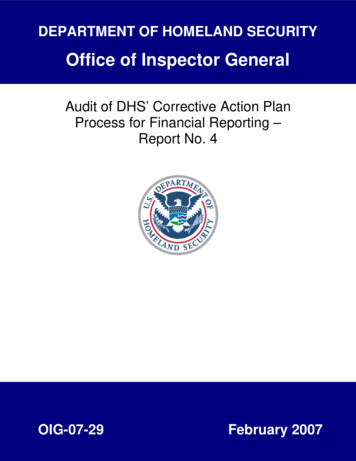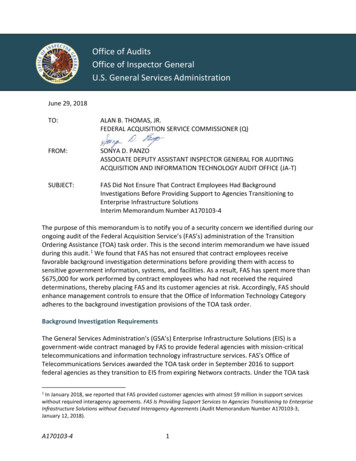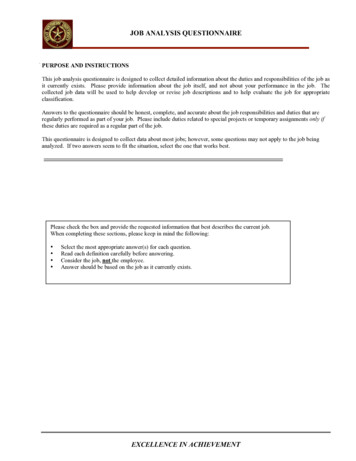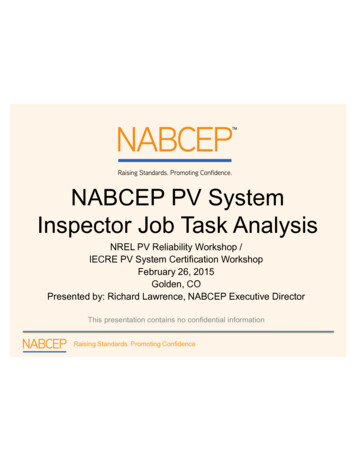
Transcription
NABCEP PV SystemInspector Job Task AnalysisNREL PV Reliability Workshop /IECRE PV System Certification WorkshopFebruary 26, 2015Golden, COPresented by: Richard Lawrence, NABCEP Executive DirectorThis presentation contains no confidential informationRaisaisinging StStandardsandards. PromPromototinging Confonfidencidencee
History The North American Board of Certified EnergyPractitioners (NABCEP) was founded in 2002 as anon-profit 501 (c)(6) corporation with a mission “tosupport, and work with, the renewable energy andenergy efficiency industries, professionals, andstakeholders to develop and implement qualitycredentialing and certification programs forpractitioners.” NABCEP’s voluntary credentials are the most widelrecognized and respected in the US solar industry. The NABCEP PV Installation Professional TM andNABCEP Solar Heating Installer TM certificationprograms are accredited to ISO/IEC 17024 by ANSI.Raising Standards. Promoting Confidence
NABCEP’s Current Schemes PV Installation Professional Certification PV Technical Sales ProfessionalCertification Solar Heating Installer Certification PV Entry Level Exam Solar Heating Entry Level Exam PV Installation Company AccreditationRaising Standards. Promoting Confidence
Job Task Analysis DevelopmentProcess OverviewRole Delineation StudyDraft Job Task Analysis (JTA) created byCommittee of SMEs during 2-day meetingIndustry Validation StudyBroad stakeholder input sought via onlinesurvey to refine and validate Draft JTAFinal Job Task Analysis PublishedNABCEP Board of Directors approves finalversion of JTA developed by the CommitteeRaising Standards. Promoting Confidence
PV System Inspector (PVSI)Target Audience Primary Audience– Individuals performing inspections of PV systems for anAuthority Having Jurisdiction (AHJ), I.E. Town ElectricalInspector, to ensure code compliance Secondary Audience– Individuals performing inspection services for utilities toensure compliance with interconnection requirements– Individuals performing inspection services for incentiveprograms, I.E. State or utility rebate programs, to ensurequality workmanship and performance– Individuals performing inspections of systems installedthrough a finance mechanism (loan, lease, PPA, utilityprogram, .)– Individuals inspecting systems to the IECRE standard?Raising Standards. Promoting Confidence
PVSI Program Objectives Increase the quality of PV SystemInspections to improve the reliability of PVSystems, protect the reputation of the PVIndustry, and ensure safe operations Facilitate training of PV System Inspectors byproviding an industry validated Job TaskAnalysis upon which curriculum can be based Provide employers and customers of PVSystem Inspectors with a tool to evaluatetheir competence at performing the jobRaising Standards. Promoting Confidence
PVSI TimelineQ3 14 Technical Committee Formed Role Delineation Study PerformedQ4 14 Draft Job Task Analysis DevelopedQ1 15 Industry Validation Study Conducted Final JTA Approved and PublishedQ2 15 Examination Committee Formed Examination Questions DevelopedQ3 15 Examination Form(s) Created and Passing Score Study Completed Credential Scheme finalizedQ4 15 First Exams AdministeredRaising Standards. Promoting Confidence
Domain I: Inspecting ElectricalComponents and SystemsDomain I: Inspecting Electrical Components and SystemsTask 1: Visually verify system labeling meets applicable codes to ensure safety.Subtask 1.1: Confirm AC interconnection point is properly labeled.CriticalSubtask 1.2: Confirm labels are of sufficient durability to withstand the environmentinvolved.Subtask 1.3: Confirm DC raceways are properly labeled.ImportantSubtask 1.4: Confirm DC disconnects are properly labeled.ImportantSubtask 1.5: Confirm AC disconnects are properly labeled.ImportantSubtask 1.6: Confirm the main service panel is properly labeled.ImportantSubtask 1.7: Confirm the inverter or other power conditioning units are properly labeled.ImportantSubtask 1.8: Confirm labels pertaining to the ungrounded system are in place (ifapplicable).Subtask 1.9: Confirm the rapid shutdown system is properly labeled (if applicable).Subtask 1.10: Confirm labels are the proper color and in legible print (not handwritten).Raising Standards. Promoting ConfidenceCriticalImportantImportantUseful
Domain I: Inspecting ElectricalComponents and Systems Cont.Domain I: Inspecting Electrical Components and SystemsTask 2: Visually and physically verify installed components match those on the approvedplans and adhere to applicable codes and standards.Subtask 2.1 Verify working clearances on components.Subtask 2.2 Ensure all components are listed, labeled, and identified for use.Subtask 2.3 Verify model numbers of components.Subtask 2.4 Confirm the number of PV modules.Subtask 2.5 Verify the National Electrical Manufacturer’s Association (NEMA) rating(indoor/outdoor/hazardous environment).Subtask 2.6 Confirm the location of components matches the plans.Task 3: Visually and physically inspect conductors and raceways to ensure safety andcompliance to applicable codes.Subtask 3.1 Verify conductor ampacity is appropriate for circuit current.Subtask 3.2 Verify the conductor type is suitable for the location and environment.Subtask 3.3 Verify the conductor voltage rating for the circuit.Subtask 3.4 Verify installation of conduit expansion joints based on length.Subtask 3.5 Ensure raceway connections are suitable for the location and environment.Subtask 3.6 Verify conductor color is correct.Subtask 3.7 Verify conduit size is suitable based on conduit fill.Subtask 3.8 Verify raceway type is suitable for the location and environment.Subtask 3.9 Ensure raceways are secured and supported properly.Raising Standards. Promoting alImportantImportantImportantImportant
Domain I: Inspecting ElectricalComponents and Systems Cont.Domain I: Inspecting Electrical Components and SystemsTask 4: Assess conductor terminations for integrity and compatibility of components toensure safety.Subtask 4.1 Verify conductor size and type are appropriate for the terminal.Subtask 4.2 Verify the conductor and terminal materials are compatible.Subtask 4.3 Verify the connection is secure.Subtask 4.4 Verify the termination device is rated for the voltage and current of the circuit.CriticalCriticalCriticalCriticalTask 5: Ensure the integrity of the grounding system by visually and physically verifyingcontinuity to ensure safety and compliance with applicable codes.Subtask 5.1 Ensure all non-current carrying metallic components are grounded.Subtask 5.2 Ensure the grounding electrode is properly installed.Subtask 5.3 Check the inverter or power conditioning unit for ground fault error when inoperation.Subtask 5.4 Ensure the equipment grounding conductor (EGC) is appropriately sized.Subtask 5.5 Ensure the grounding electrode conductor (GEC) is continuous andappropriately sized.Raising Standards. Promoting nt
Domain I: Inspecting ElectricalComponents and Systems Cont.Domain I: Inspecting Electrical Components and SystemsTask 6: Visually and physically inspect the point of PV system interconnection with theutility grid for compliance with applicable codes, following standard electrical safetypractices.Subtask 6.1: Verify the interconnection devices are appropriate for use.Subtask 6.2: Verify the maximum current fed to the busbar does not exceed code limitations.Subtask 6.3: Verify the proper installation of the overcurrent protection device for thesupply-side interconnection.Subtask 6.4: Confirm the location of interconnection devices.Task 7: Verify proper sizing and ratings of overcurrent protection devices per applicablecodes and standards to ensure safety.Subtask 7.1: Confirm voltage limitations of the overcurrent protection devices.Subtask 7.2: Confirm circuit current calculations.Subtask 7.3: Confirm characteristics of existing electrical distribution system.Subtask 7.4: Confirm the allowable interrupting current ratings of overcurrent protectiondevices.Subtask 7.5: Confirm the selection of overcurrent protection enclosures.Subtask 7.6: Confirm current limits of overcurrent protection devices.Raising Standards. Promoting lCriticalCriticalCriticalImportantImportant
Domain II: Inspecting Energy StorageComponents and SystemsDomain II: Inspecting Energy Storage Components and SystemsTask 1: Verify PV array design and control per applicable codes and standards to ensure safety.Subtask 1.1: Verify conductor sizing is appropriate for array and charge controller ampacity.Subtask 1.2: Verify the size and rating of overcurrent protection devices (OCPD) for array andcharge controller conductors.Subtask 1.3: Confirm the charge controller is suitable for the type of storage used.Task 2: Verify the energy storage system design and installation adheres to applicable codesand standards to ensure safety.Subtask 2.1: Verify the mechanical enclosure is sufficient to support the weight of the batterybank.Subtask 2.2: Verify the grounding of any metal structures.Subtask 2.3: Verify proper working clearance around batteries.Subtask 2.4: Verify the battery enclosure has appropriate ventilation when required.Subtask 2.5: Confirm the battery conductors and terminals are compliant and conductorinsulation is appropriate.Subtask 2.6: Verify seismic structural requirements meet applicable codes and standards.Subtask 2.7: Ensure the provision for the containment of battery acid if appropriate.Subtask 2.8: Verify the battery disconnect location.Subtask 2.9: Verify the battery overcurrent protection device(s) (OCPD) are appropriate forinverter output.Subtask 2.10: Verify code-compliant labeling.Raising Standards. Promoting ntImportantImportant
Domain II: Inspecting Energy StorageComponents and Systems Cont.Domain II: Inspecting Energy Storage Components and SystemsTask 3: Verify the operation of the multi-mode inverter complies with applicable codes andstandards to ensure safety.Subtask 3.1: Verify the proper installation and usage of the multimode inverter.ImportantSubtask 3.2: Verify the proper interconnection of system components.ImportantTask 4: Verify the inverter AC connections comply with applicable codes and standards toensure safety.Subtask 4.1: Verify the proper AC overcurrent protection devices (OCPD) and conductors.Subtask 4.2: Verify the overcurrent protection device is sized properly for bidirectionalcurrent flow at grid connection.CriticalSubtask 4.3: Verify the installation and rating of the critical load panel.CriticalSubtask 4.4: Verify proper generator sizing and interconnection as required.Raising Standards. Promoting ConfidenceCriticalImportant
Domain III Inspecting Mechanical /Structural ComponentsDomain III: Inspecting Mechanical/Structural Components and SystemsTask 1: Inspect roof-mounted components and systems to verify integrity and compliancewith applicable codes to ensure longevity and safety.Subtask 1.1: Verify quantity and type of attachment points for racking.Subtask 1.2: Verify the integrity of structural members.Subtask 1.3: Verify the proper use of any dissimilar metals to avoid corrosion and deterioration.Subtask 1.4: Verify ballast weights and placement.Subtask 1.5: Inspect flashing and weather sealing.Subtask 1.6: Verify module attachments meet listing requirements.Subtask 1.7: Verify equipment is installed securely and meets listing requirements.Subtask 1.8: Verify junction boxes and disconnects are mounted securely and meet listingrequirements.Subtask 1.9: Verify the racking system is properly mounted and meets listing requirements.Subtask 1.10: Inspect modules for physical damage.Subtask 1.11: Verify the rooftop array configuration meets setback requirements as defined byapplicable codes and standards.Subtask 1.12: Verify the location of attachment points.Subtask 1.13: Verify the integrity of attachment points into/on the structure.Subtask 1.14: Verify the array structure is level and plumb.Raising Standards. Promoting portantImportantUseful
Domain III Inspecting Mechanical /Structural Components Cont.Domain III: Inspecting Mechanical/Structural Components and SystemsTask 2: Inspect ground-mounted components and systems to verify integrity and compliancewith applicable codes to ensure longevity and safety.Subtask 2.1: Verify the proper use of any dissimilar metals to avoid corrosion and deterioration.CriticalSubtask 2.2: Verify module attachments meet listing requirements.CriticalSubtask 2.3: Verify equipment is installed securely and meets listing requirements.CriticalSubtask 2.4: Verify DC conductors are not readily accessible.CriticalSubtask 2.5: Confirm foundation inspection documentation if applicable.Subtask 2.6: Verify the ground-mounted array location meets setback requirements as definedby local jurisdictional requirements.Raising Standards. Promoting ConfidenceImportantUseful
Domain IV: Documentation for theSystem InspectionDomain IV: Documentation for the System InspectionTask 1: Review permit package for accuracy, completeness, and compliance with applicablecodes to ensure a safe and functioning system design.Subtask 1.1: Verify a site diagram includes the location of major components.Subtask 1.2: Verify the electrical diagram includes information on electrical components, wiringmethods, and electrical connection to the utility service.Subtask 1.3: Verify string sizing for compatibility with the inverter or other power conditioningunit.Subtask 1.4: Ensure the permit package includes the specification sheets for majorcomponents.Subtask 1.5: Verify the permit plans identify an array that is mounted on a code-compliant andpermitted structure.Subtask 1.6: Verify the permit plans identify a mounting ulTask 2: Quantify and report deviations of the installed system from design documentation andapplicable codes and standards for various stakeholders.Subtask 2.1: Report any deviation from the manufacturer’s specifications.Subtask 2.2: Report any code violations.Subtask 2.3: Report any deviation from submitted design documentation.Subtask 2.4: Present supporting documentation (e.g., photographs, measurements, technicaldocuments, code reference).Raising Standards. Promoting ConfidenceCriticalCriticalImportantImportant
PVSI Validation Study NABCEP will be conducting an IndustryValidation Study of the Draft PV SystemInspector Job Task Analysis in March/April2015. To access the survey during this time andprovide feedback on the DRAFT PVSystem Inspector JTA please visitwww.nabcep.org or e-mailinfo@nabcep.org to request an invitation.Raising Standards. Promoting Confidence
NABCEP’s CurrentSchemes PV Installation Professional Certification PV Technical Sales Professional Certification Solar Heating Installer Certification PV Entry Level Exam Solar Heating Entry Level Exam PV Installation Comp

